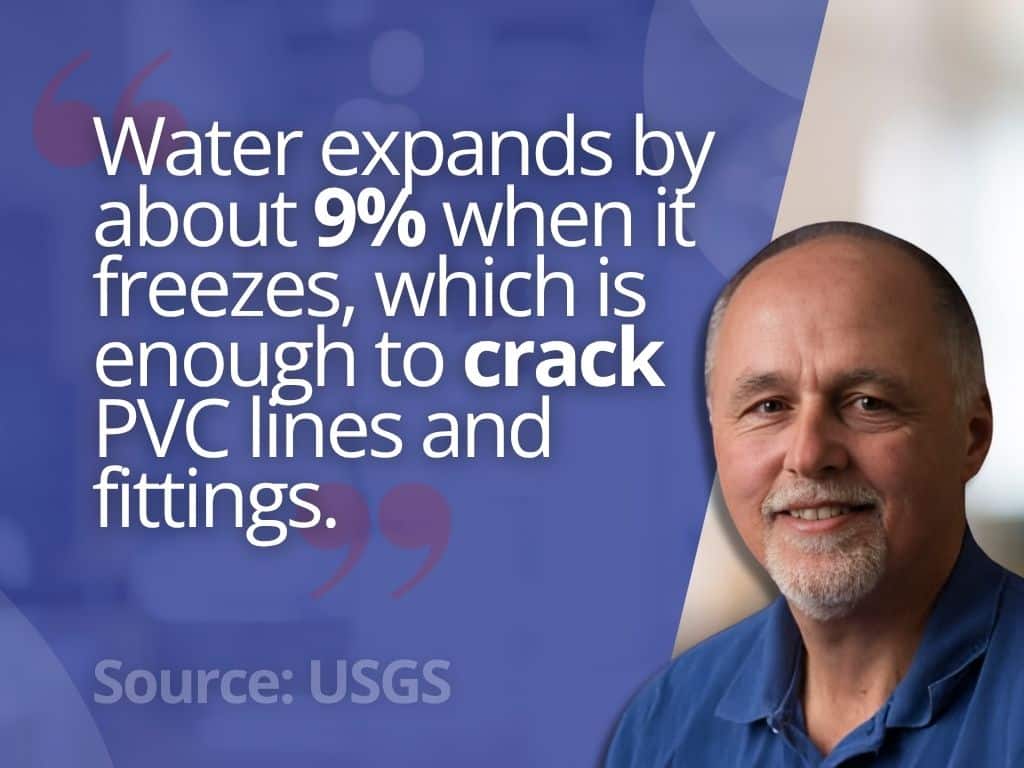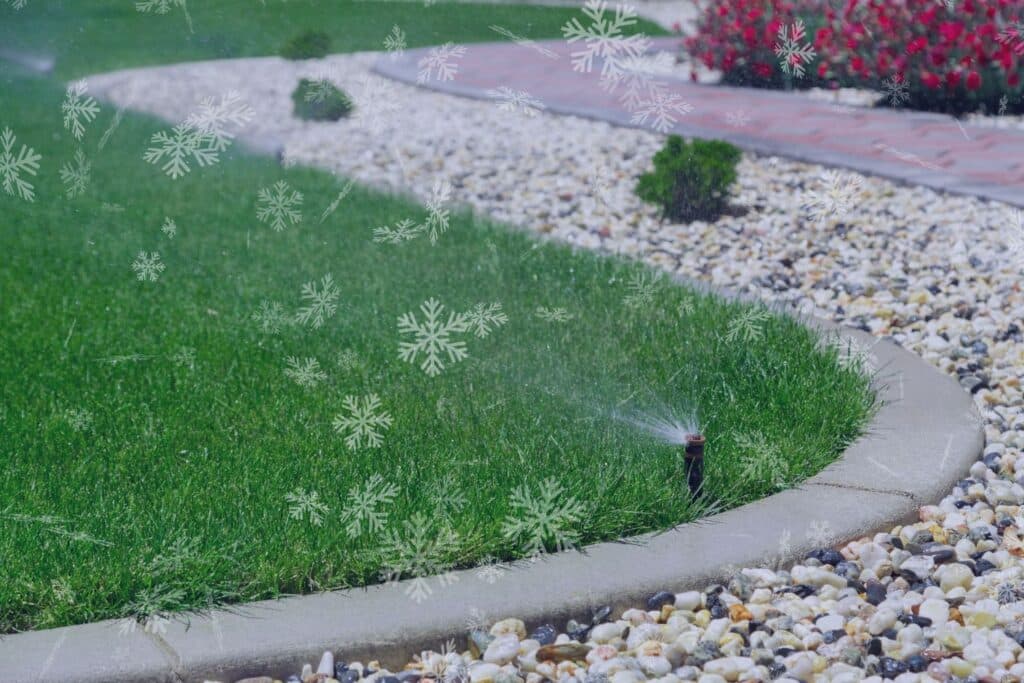If you live in Charlotte or a nearby North Carolina community, making sure to winterize your sprinkler system is an important seasonal task to protect your lawn irrigation setup. The good news is that, in North Carolina, it’s easier than many homeowners think.
Most systems only need a few simple steps to stay safe through the winter. If your system has special components or if you are unsure how it was installed, a professional can check it before temperatures drop.
This guide explains exactly how to winterize your sprinkler system, when to do it, and the safety steps that matter most. The team at America’s Choice Inspections helps homeowners throughout the Charlotte area evaluate irrigation systems, identify weak points, and avoid seasonal damage.
Why Winterizing Matters in North Carolina
Even though North Carolina falls and winters are mild, freezing nights still cause sprinkler lines to burst, especially shallow lines and exposed valves.
Charlotte, Concord, Gastonia, Huntersville, and the surrounding areas sit in a freeze risk zone. Winter temperatures can swing from warm afternoons to freezing nights with little warning. These sudden drops are enough to freeze residual water inside:
• Irrigation pipes
• Spray lines
• Backflow preventers
• Valves
• Underground connections
• Aboveground components

When water freezes, it expands with enough force to split fittings or create long cracks in PVC lines. Repairs are often expensive, and hidden leaks can waste water for months before you notice.
Winterizing prevents:
• Line damage
• Water waste
• Underground leaks
• Flooded valve boxes
• Backflow preventer failures
• Mold or moisture issues around exterior walls
For homeowners in the Charlotte area, winterizing is an easy way to avoid frustration once spring arrives.
What’s the Best Time to Winterize a Sprinkler System?
Most North Carolina homeowners should complete winterization sometime between:
• Late October
• Mid-November
However, winterizing earlier may be smart if:
• Your system has shallow lines
• Your yard sits in a low area
• Your backflow preventer is exposed
• You live north of Charlotte or at a higher elevation
Charlotte has occasional early freeze warnings. When night temperatures consistently fall into the low 30s, it is time to shut the system down.
A good rule is to winterize before Thanksgiving so your irrigation lines are fully protected.
How Do Sprinkler Systems Freeze?
Sprinkler systems do not need active water flow to freeze. Even clean, well-installed systems hold enough water in:
• Fittings
• Risers
• Backflow devices
• Valves
• Line bends
This leftover water is enough to cause cracks. A single hard freeze can damage a valve or section of pipe even if the rest of the system is dry.
Charlotte’s freeze events are usually brief, but that does not reduce the risk. Sudden temperature drops are usually the cause of sprinkler damage in NC.
How to Winterize Your NC Sprinkler System
In short: Shut off the water, open the system, drain leftover water, and protect the backflow preventer.
Below is the full step-by-step winterization process that works for most North Carolina systems. If you have a basement shutoff, multiple zones, property slopes, or older valves, a professional may need to check your setup.
Step 1: Shut Off the Water Supply
Find the irrigation water shutoff valve. Common locations include:
• A valve box near the street
• Inside the garage
• Inside a crawl space
• Near the main water meter
• Attached to the backflow preventer
Turn the handle to the off position. Some systems have a drain port next to the shutoff valve. If yours does, leave it open once the system is off.
Step 2: Turn Off the Controller
Your irrigation controller keeps your system running on a schedule. During winter, it should not cycle automatically.
On most controllers:
• Switch to “Off” or “Rain Mode”
• Leave the power connected so the programming stays saved
Do not unplug the controller unless your installer recommended it. Some controllers need power to avoid resetting.
Step 3: Drain the System
North Carolina systems usually fall into one of three categories:
- 1. Manual Drain Systems: These have drain valves at low points in the yard. Open each drain valve until all water stops flowing. Leave the valves open until spring.
- 2. Automatic Drain Systems: Some systems have valves that open automatically when pressure drops. Even with these, it is smart to check a few low points to confirm water has drained.
- 3. Blowout Systems: Contractors use compressed air to blow water out of each zone. Many NC homeowners use this method if their lines are shallow or if the system has long runs.
Blowing out a system should be done by a professional. Too much pressure can damage pipes.
Visual idea: Chart comparing the three drain types and what each requires.
Step 4: Protect the Backflow Preventer
Backflow preventers are exposed components often mounted on the side of the house. They freeze quickly because they contain water and sit above ground.
To protect yours:
• Turn the test cocks to a 45-degree angle
• Open the ball valves to allow air movement
• Wrap the assembly with insulation
• Cover it with a weatherproof backflow cover
Do not wrap the backflow preventer with plastic alone. Plastic traps moisture, which can freeze inside.
Step 5: Open All Zone Valves
Opening valves allows any trapped water to escape. You may find valves in:
• Valve boxes around the yard
• Near the backflow preventer
• In the basement
• Near exterior walls
Open each zone valve slowly. Water may trickle out for a few minutes.
Step 6: Check for Low Spots
Areas of your yard where lines dip below grade tend to hold water. Look for:
• Valve boxes that fill with water
• Muddy soil above the irrigation line path
• Zones that drain more slowly than others
These areas may need extra attention during winterization. A professional can check the slope and depth if you are unsure.
Step 7: Insulate Exposed Components
Use foam insulation or covers to protect:
• Backflow preventers
• Aboveground valves
• Exposed pipes
• Pressure regulators
Do not block air vents or test ports. The goal is to keep the cold wind off the components.
Step 8: Confirm Your System Is Fully Winterized
Your system is ready for winter when:
• Water is shut off
• Controller is off
• Lines are drained
• Backflow preventer is insulated
• All zone valves are open
• Exposed parts are protected
Most North Carolina homes can winterize a system in under an hour once you know where each part is located.
Common Winterization Mistakes
Most problems happen when water is left in the backflow preventer or shallow lines.
Here are the most common mistakes:
• Only turning off the controller
• Forgetting the main shutoff
• Not draining low points
• Leaving the backflow preventer full of water
• Wrapping the backflow with plastic
• Using a home air compressor at unsafe pressure
• Winterizing too late in the season
These issues cause leaks, cracked fittings, and spring flooding.
Signs Your Sprinkler Was Not Winterized Correctly
Look for…
• Water pooling near valve boxes
• Dripping or spraying from the backflow preventer
• Soggy patches along water lines
• Rising water bills
• Low pressure in one or more zones
• Bubbling soil in early spring
If you notice any of these issues, shut off the system and schedule an inspection.
Costs for Winterizing a Sprinkler System in NC
Typical costs for winterizing in the Charlotte area include:
| Task | Cost Range |
| Basic winterization | 65 to 150 dollars |
| Backflow preventer insulation | 10 to 50 dollars |
| Professional blowout | 75 to 175 dollars |
| Minor repairs discovered during winterization | 50 to 300 dollars |
Costs vary based on system size, number of zones, and how easy the equipment is to access.
Other Helpful Questions
What other exterior systems should I check before winter?
Homeowners often review gutters, downspouts, grading, exterior plumbing, and hose bibs at the same time they winterize their sprinkler system. These areas help prevent moisture issues, foundation movement, and early wear on exterior components.
How do drainage problems impact foundations or crawl spaces?
Poor drainage can create standing water, high humidity, and soil settlement that show up as cracks, sloping floors, or structural movement during foundation or crawl space evaluations.
Are irrigation leaks something that could appear during a pre-listing inspection?
Yes. Hidden line damage, backflow issues, or wet spots in the yard often show up in pre-listing reports and may need simple repairs before listing a home.
How can homeowners spot early electrical or HVAC issues while preparing for winter?
Tripping breakers, inconsistent heating, restricted airflow, and unusual system cycling are common symptoms that may surface in an electrical or HVAC inspection.
When to Call a Professional
Call a professional when:
• You cannot locate the shutoff valve
• Your system has multiple zones or slopes
• Your backflow preventer is older or leaking
• You prefer a professional blowout
• You had freeze damage in the past
• You want a full irrigation inspection before winter
America’s Choice Inspections helps homeowners identify risks, understand their irrigation system layout, and protect the system before cold weather hits.
Conclusion
Winterizing your sprinkler system is one of the easiest ways to avoid leaks, cracked pipes, and costly spring repairs. In North Carolina’s climate, all it takes is a single cold night to cause damage. Shutting off the system, draining the lines, and protecting the backflow preventer are the key steps.
If you are unsure how your system is set up or want a professional to take a closer look, schedule service with America’s Choice Inspections to protect your irrigation system and keep your home ready for winter.


